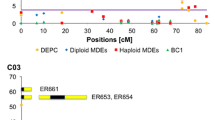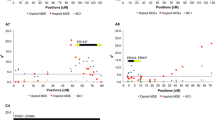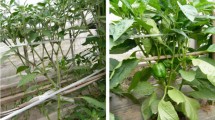Abstract
Key message
We identified three physical positions associated with embryo yield in microspore culture of Brassica rapa by segregation distortion analysis. We also confirmed their genetic effects on the embryo yield.
Abstract
Isolated microspore culture is well utilized for the production of haploid or doubled-haploid plants in Brassica crops. Brassica rapa cv. ‘Ho Mei’ is one of the most excellent cultivars in embryo yield of microspore culture. To identify the loci associated with microspore embryogenesis, segregation analysis of 154 DNA markers anchored to B. rapa chromosomes (A01–A10) was performed using a population of microspore-derived embryos obtained from an F1 hybrid between ‘CR-Seiga’, a low yield cultivar in microspore-derived embryos, and ‘Ho Mei’. Three regions showing significant segregation distortion with increasing ‘Ho Mei’ alleles were detected on A05, A08 and A09, although these regions showed the expected Mendelian segregation ratio in an F2 population. The additive effect of alleles in these regions on embryo yield was confirmed in a BC3F1 population. One region on A08 containing Br071-5c had a higher effect than the other regions. Polymorphism of nucleotide sequences around the Br071-5c locus was investigated to find the gene possibly responsible for efficient embryogenesis from microspores.

Similar content being viewed by others
References
Ajisaka H, Kuginuki Y, Shiratori M, Ishiguro K, Enomoto S, Hirai M (1999) Mapping of loci affecting the cultural efficiency of microspore culture of Brassica rapa L. syn. campestris L. using DNA polymorphism. Breed Sci 49:187–192
Baillie AMR, Epp DJ, Hutcheson D, Keller WA (1992) In vitro culture of isolated microspores and regeneration of plants in Brassica campestris. Plant Cell Rep 11:234–237
Boutilier K, Offringa R, Sharma VK, Kieft H, Ouellet T, Zhang L, Hattori J, Liu CM, van Lammeren AAM, Miki BLA, Custers JB, van Lookeren Campagne MM (2002) Ectopic expression of BABY BOOM triggers a conversion from vegetative to embryonic growth. Plant Cell 14:1737–1749
Burnett L, Yarrow S, Huang B (1992) Embryogenesis and plant regeneration from isolated microspores of Brassica rapa ssp. oleifera. Plant Cell Rep 11:215–218
Chalhoub B, Denoeud F, Liu S, Parkin IA, Tang H et al (2014) Early allopoly-ploid evolution in the post-Neolithic Brassica napus oilseed genome. Science 345:950–953
Choi SR, Graham RT, Prikshit P, Kim JH, Allender CJ et al (2007) The reference genetic linkage map for the multinational Brassica rapa genome sequencing project. Theor Appl Genet 115:777–792
Cloutier S, Cappadoci M, Landry BS (1995) Study of microspore-culture responsiveness in oilseed rape (Brassica napus L.) by comparative mapping of a F2 population and two microspore-derived populations. Theor Appl Genet 91:841–847
Cordewener JHG, Hause G, Gorgen E, Busink R, Hause B, Dons HJM, van Lammeren AAM, van Lookeren CMM, Pechan P (1995) Changes in synthesis and localization of members of the 70-kDa class of heat-shock proteins accompany the induction of embryogenesis in Brassica napus L. microspores. Planta 196:747–755
Doyle JJ, Doyle JL (1990) Isolation of plant DNA from fresh tissue. Focus 12:13–15
Ferrie AMR, Caswell KL (2011) Isolated microspore culture techniques and recent progress for haploid and doubled haploid plant production. Plant Cell, Tissue Organ Cult 104:301–309
Fujimoto R, Sugimura T, Nishio T (2006) Gene conversion from SLG to SRK resulting in self-compatibility in Brassica rapa. FEBS Lett 580:425–430
Germanà MA (2011) Anther culture for haploid and doubled haploid production. Plant Cell, Tissue Organ Cult 104:283–300
Gland-Zwerger A, Lichter R, Schweger HG (1988) Genetic and exogenous factors affecting embryogenesis in isolated microspore cultures of Brassica napus L. J Plant Physiol 132:613–617
Hisamatsu M, Odahara K, Matsu Y (1994) A survey of microspore embryogenesis in leaf mustard (Brassica juncea). Abstr. Of XXIVth Int. Hort. Congr, Kyoto Japan
Kameya T, Hinata K (1970) Induction of haploid plants from pollen grains of Brassica. Jpn J Breed 20:82–87
Keller WA, Armstrong KC (1979) Stimulation of embryogenesis and haploid production in Brassica campestris anther cultures by elevated-temperature treatments. Theor Appl Genet 55:65–67
Keller WA, Rajhathy R, Lacapra J (1975) In vitro production of plants from pollen in Brassica campestris. Can J Genet Cytol 17:655–666
Kim HR, Choi SR, Bae J, Hong CP, Lee SY, Hossain MJ, Nguyen DV, Jin M, Park BS, Bang JW, Bancroft I, Lim YP (2009) Sequences BAC anchored reference genetic map that reconciles the ten individual chromosomes of Brassica rapa. BMC Genom 10:432
Li F, Kitashiba H, Inaba K, Nishio T (2009) A Brassica rapa linkage map of EST-based SNP markers for identification of candidate genes controlling flowering time and leaf morphological traits. DNA Res 16:311–323
Lichter R (1982) Induction of haploid plants from isolated pollen of Brassica napus. Z Pflanzenphysiol 105:427–434
Lichter R (1989) Efficient yield of embryoids by culture of isolated microspores of different Brassicaceae species. Plant Breed 103:119–123
Malik MR, Wang F, Dirpaul JM, Zhou N, Polowick PL, Ferrie AM, Krochko JE (2007) Transcript profiling and identification of molecular markers for early microspore embryogenesis in Brassica napus. Plant Physiol 144:134–154
Meinke DW, Franzmann LH, Nickle TC, Yeung EC (1994) Leafy cotyledon mutants of Arabidopsis. Plant Cell 6:1049–1064
Miwa H, Kinoshita A, Fukuda H, Sawa S (2009) Plant meristem: CLAVATA3/ESR-related signaling in the shoot apical meristem and the root apical meristem. J Plant Res 122:31–39
Ohkawa Y, Nakajima K, Keller WA (1987) Ability to induce embryoids in Brassica napus cultivars. Jpn J Breed 37(Suppl. 2):44–45
Pagnussat GC, Yu HJ, Ngo QA, Rajani S, Mayalagu S, Johnson CS, Capron A, Xie LF, Ye D, Sundaresan V (2005) Genetic and molecular identification of genes required for female gametophyte development and function in Arabidopsis. Development 132:603–614
Parcy F, Valon C, Raynal M, Gaubier-Comella P, Delseny M, Giraudat J (1994) Regulation of gene expression programs during Arabidopsis seed development: roles of the ABI3 locus and of endogenous abscisic acid. Plant Cell 6:1567–1582
Sato T, Nishio T, Hirai M (1989) Plant regeneration from isolated microspore cultures of Chinese cabbage (Brassica campestris ssp. pekinensis). Plant Cell Rep 8:486–488
Shiokai S, Shirasawa K, Sato Y, Nishio T (2010) Improvement of the dot-blot-SNP technique for efficient and cost-effective genotyping. Mol Breed 25:179–185
Takahashi Y, Yokoi S, Takahata Y (2011) Improvement of microspore culture method for multiple samples in Brassica. Breed Sci 61:96–98
Takahata Y, Keller WA (1991) High frequency embryogenesis and plant regeneration in isolated microspore culture of Brassica oleracea L. Plant Sci 74:235–242
Takahata Y, Komatsu H, Kaizuma N (1996) Microspore culture of radish (Raphanus sativus L.): influence of genotype and culture conditions on embryogenesis. Plant Cell Rep 16:163–166
Thomas E, Wenzel G (1975) Embryogenesis from microspores of Brassica napus. Z Pflanzenzüchtg 74:79–81
Tonosaki K, Michiba K, Bang SW, Kitashiba H, Kaneko Y, Nishio T (2013) Genetic analysis of hybrid seed formation ability of Brassica rapa in intergeneric crossings with Raphanus sativus. Theor Appl Genet 126:837–846
Tsuwamoto R, Fukuoka H, Takahata Y (2007) Identification and characterization of genes expressed in early embryogenesis from microspores of Brassica napus. Planta 225:641–652
Wang X, Wang H, Wang J, Sun R, Wu J, Liu S, Bai Y, Jeong-Hwan M, Bancroft I, Cheng F, Huang S, Li X, Hua W, Wang J, Wang X, Freeling M, Pires JC, Paterson AH, Chalhoub B, Wang B, Hayward A, Sharpe AG, Beom-Seok P, Weisshaar B (2011) The genome of the mesopolyploid crop species Brassica rapa. Nat Genet 43:1035–1039
Zhang F, Takahata Y (2001) Inheritance of microspore embryogenic ability in Brassica crops Theor. Appl Genet 103:254–258
Zhang F, Aoki S, Takahata Y (2003) RAPD markers linked to microspore embryogenic ability in Brassica crops. Euphytica 131:207–213
Acknowledgments
This work was supported in part by a Grant-in-Aid for Scientific Research (B) (No. 18380003) from the Japan Society for the Promotion of Science (JSPS) and the Program for Promotion of Basic and Applied Researches for Innovations in Bio-oriented Industry (BRAIN).
Author information
Authors and Affiliations
Corresponding author
Ethics declarations
Conflict of interest
The authors declare that they have no conflict of interest.
Additional information
Communicated by K. Toriyama.
Electronic supplementary material
Below is the link to the electronic supplementary material.
Rights and permissions
About this article
Cite this article
Kitashiba, H., Taguchi, K., Kaneko, I. et al. Identification of loci associated with embryo yield in microspore culture of Brassica rapa by segregation distortion analysis. Plant Cell Rep 35, 2197–2204 (2016). https://doi.org/10.1007/s00299-016-2029-4
Received:
Accepted:
Published:
Issue Date:
DOI: https://doi.org/10.1007/s00299-016-2029-4




